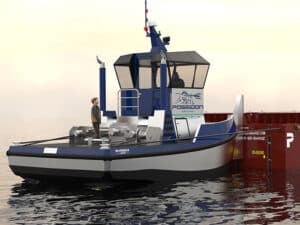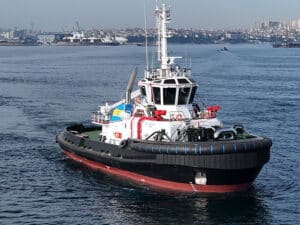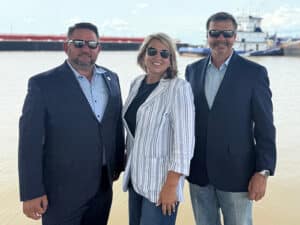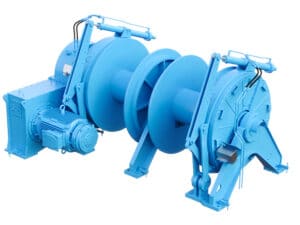
Transitioning America’s maritime academies to accommodate new training vessels
Written by
State-Class Training Ship Empire State, a National Security Multi-Mission Vessel. Credit: Courtesy of RMF Engineering
By RMF Engineering‘s Andrew Hay, P.E., Division Manager, Infrastructure Engineering; Michael Wilkins, P.E., Project Manager; and Kevin Kikola, P.E., Project Manager
The United States’ five State Maritime Academies—California, Maine, Massachusetts, State University of New York (SUNY), and Texas A&M University at Galveston—are responsible for educating the next generation of officers in the merchant marine.
Graduates are integral to national security and maritime defense readiness. To best prepare students for that important responsibility, the U.S. Maritime Administration (MARAD) has been gradually working to decommission and replace the academies’ current fleet of training ships, which were originally designed for the use of steam power and have begun to age beyond their viability.
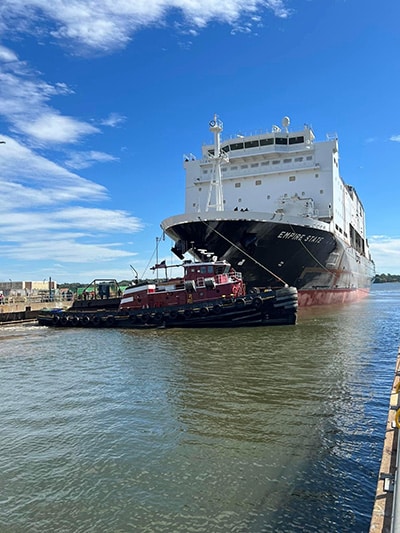
The new vessel program—known as National Security Multi-Mission Vessels (NSMVs)—will completely modernize the academies’ training abilities, better reflecting current trends and operations in the shipping industry. The academies selected by MARAD for training vessel replacement must undergo significant pier and infrastructure overhauls to support the berthing conditions established for NSMV—a requirement of the MOA with MARAD and a condition of federal support.
RMF Engineering has been working in partnership on facilitating the transition for a number of these academies, bringing both a technical background in complex, higher education infrastructure projects, and experience in utility distribution to bridge the gap with the maritime needs for these schools.
Changes and Challenges
The incoming vessels are different in size, construction, appearance, as well as utility needs from the existing, aging training ships. A powerful national asset, the NSMV was designed to provide world-class training for the U.S.’s future mariners and to support humanitarian assistance and disaster relief missions in times of need—bringing on-board state-of-the-art hospital facilities, a helicopter landing pad, and the ability to berth up to 1,000 people in times of humanitarian need. Alongside its disaster relief capacities, the NSMV has a roll-on/roll-off ramp and container storage allowing it to provide aid to damaged ports. Consequently, when berthed at any given academy, the NSMV will have a shore power electrical demand between 2000kVA to 4000kVA, depending upon weather and operating conditions.
The existing utility systems on campus, the local utility costs for energy, and the port’s proximity to other landmarks, systems, and structures all play a role in RMF’s strategy to achieve the power demands required. The maritime environments also provide unique challenges to consider when designing resilient utility systems, such as floodplain elevations, groundwater levels, and the corrosive nature of salt water. These complexities are further compounded by the fact that higher education institutions bring their own set of considerations, continued academic instruction, campus life and events, campus aesthetics, community stakeholders, and maritime operations resulting in each academy requiring a completely individualized approach based on its context.
SUNY, Massachusetts, and Maine
At SUNY Maritime—the first academy to receive upgrades in preparation for the new NSMV, the Empire State—RMF Engineering designed the academy’s new shoreside infrastructure needed to accommodate the ship’s delivery later this year (2023). A comprehensive load analysis was conducted on the new vessel’s shore power demand for a variety of MARAD stipulated conditions. This analysis was reviewed with the local utility and the ship’s crew for specific operational input. The result indicated that the electrical demand (kWh) would increase to six times the demand of the existing vessel on a yearly basis, doubling the existing campus load.
To support this increase, a new 15kV service feeder was required from the utility company. Enhancing campus resiliency, a new 15kV service entrance switchgear was also installed on an elevated platform, which would protect it from storm surge, as well as potential utility feeder failures. New, redundant 6.6kV power feeders were distributed throughout the campus to serve the new ship.
Capitalizing on the existing campus steam generation and onboard steam-to-hot water heat exchanger, RMF also designed a replacement 50psi steam line from the existing plant to the pier. This approach allowed the campus to curtail the electrical demand of the vessel in winter months, as the hot water provided supplemental heating in spaces.
As more information became available from MARAD while the infrastructure upgrades took place, however, it was determined that the existing pier structure would not be capable of supporting the lateral loads of NSMV during heavy weather mooring. RMF partnered with McLaren Engineering Group to design an upgrade to the academy’s pier structure and utilities to accommodate the new vessel and future campus growth. The pier upgrades included new mooring dolphins, new concrete piles, and new pier deck including utility distribution trenches.
Massachusetts Maritime Academy will receive the second NSMV, the Patriot State, scheduled for delivery in 2024. RMF partnered with GEI Consultants to design the academy’s new shoreside infrastructure, leveraging many of the lessons learned at SUNY. In particular, the load analysis was reviewed very early with the local utility and the campus operations personnel for specific operational input. In contrast to SUNY, Massachusetts Maritime made the determination that the shore power connection would be designed to support the vessel during normal academic shore-side operations.
This decision limited the increased load to 2,000kVA, which still required an additional dedicated service feeder from the local utility and would require the vessel to run on onboard power during any emergency event. A new 25kV service entrance feeder was distributed throughout the campus and then transformed to 6.6kV to serve the new vessel.
Like SUNY, Massachusetts Maritime sought to utilize its existing steam generation to offset the electrical heating of the Patriot State when at shore in the winter months. RMF’s assessment, however, found that the steam system in place lacked the capacity to meet the peak demand of the ship’s heat exchanger. Evaluating the economics of the local electricity rates versus the steam operating costs, along with the cost of increasing shore-side steam generation capacity, RMF determined that increasing the shore-side steam generation capacity to the peak demand of the vessel would require additional plant footprint.
It also would not be as cost effective an investment, as peak conditions rarely occur. A plant replacement was designed to increase the system capacity as much as possible, while maximizing the existing building footprint. This allows the shore-side steam generating capacity to provide more than double the average demand from the ship’s heating system, despite being only roughly 50% of the peak demand.
The third NSMV will be delivered to Maine, whose academy shares a port with its historic coastal town—requiring careful coordination and planning to support the variety of vessels that berth there. An expanded concrete pier, built on steel pilings, will replace the existing timber-construction, with new utility connections designed specifically to support the NSMV running beneath, including new underground steam lines, sewer lines and water lines. Like SUNY and Massachusetts Maritime, a new utility service was required to support the load of the NSMV and new 6.6kV infrastructure was distributed to the pier.
Once again, RMF completed a load analysis that was reviewed very early with the local utility. Following an upgrade to the local utility’s 35kV distribution line, a new 12.5kV service entrance feeder is to be brought in and transformed and distributed at 6.6kV with a 3750kVA capacity throughout the campus to serve the new vessel.
RMF also worked with a design team led by GZA to provide upgraded infrastructure and waterfront improvements. The existing steam plant at Maine Maritime had no room for growth, and currently runs exclusively on No. 2 oil, increasing the operating cost of the plant when compared to natural gas. Instead of increasing the plant’s capacity, other buildings currently served by the plant are being fitted with local boilers to increase available steam capacity to the vessel.
Conclusion
Despite the consistency across each NSMV, all three campuses required highly tailored approaches to solve the unique challenges and design criteria. RMF’s comprehensive and nuanced strategies for SUNY, Massachusetts Maritime, and Maine Maritime not only equip them to receive the new ships, but will best support the continued academic programs and the communities surrounding each campus.
By 2025, the fourth ship is expected to be received by the Maritime Academy at Texas A&M University at Galveston, and the fifth vessel will go to the California State University Maritime Academy in Vallejo, Calif., which will both come with their own unique challenges. The California site in particular sits at the base of a large mountain in an active seismic zone with tightly controlled utility options, creating a dynamic mix of considerations and logistical challenges.

